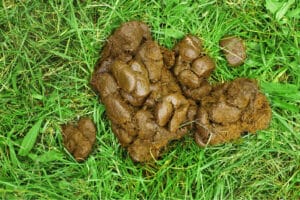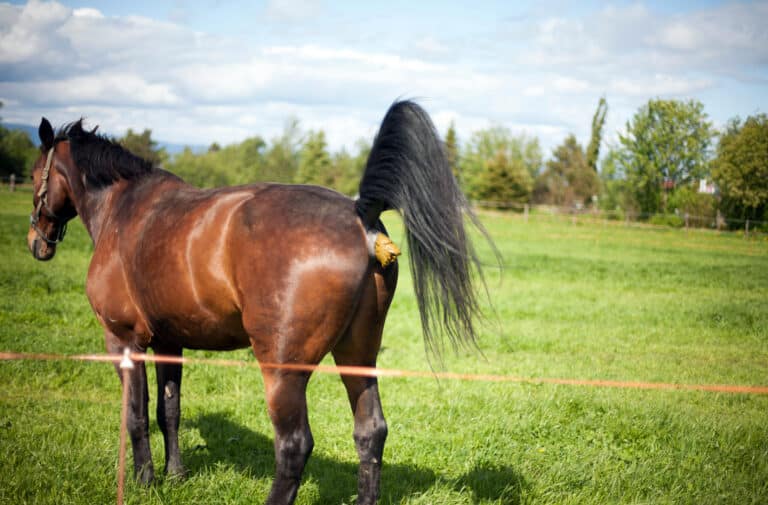Coprophagy, or eating manure, is more common than you might think. PETER HUNTINGTON B.V.Sc., M.A.C.V.Sc. explains.
Why do horses eat manure? It seems revolting to us, but horses and other animals such as dogs do it quite commonly. We think that all the horse eats is the concentrated feed we provide plus forage such as hay or pasture, but often horses also eat wood, bark, leaves, dirt and manure.
Coprophagy, or eating manure, is normal and very common in young horses. Foals are thought to eat manure to populate their hindgut with beneficial bacteria, the totality of which is called the intestinal microbiome. The hindgut microbiome is vital for digestion of fibre into volatile fatty acids, production of B Vitamins, intestinal health, immunity, health, and normal behaviour.

Mature horses that ingest manure are less common, and the behaviour is often associated with a lack of long-stem fibre from pasture or hay in the diet. Horses that consume a low fibre, high grain diet, or a protein deficient diet may engage in coprophagy.
When grass begins to grow in the spring, it provides abundant forage that is high in moisture and carbohydrates, but low in fibre. Often you will see that horses have loose manure at that time of year, reflecting hind gut acidosis and disturbances in the microbiome. An easy dietary adjustment is to increase the amount of forage by increasing hay intake to at least 1% of body weight per day.
Horses have a good innate sense of the need for fibre. In both dry times and when there is lush pasture, if you offer hay the horse will eat it to satisfy their fibre requirement. If they don’t need it they will leave it. When the water content of the pasture reduces and the fibre increases, they often start leaving the hay. Then you can reduce what you offer them as there is no point in wasting it.
What else could be in manure that they want or need? If the horse is on a restricted feed intake and is hungry, dry matter may be desired. The hindgut microbiome produces volatile fatty acids (an energy source), B group Vitamins and Vitamin K, and these will be present in manure and could be recycled. Whether they would survive transit through the acidic environment of the stomach is unknown and with most manure consumption being small scale, it probably wouldn’t make a significant difference to the energy or vitamin status of the horse.
Straw, shavings, sawdust, and even pelleted bedding seem to be delicacies to some horses. Good doers and hungry horses, such as those engaged in a weight-loss program, are frequent culprits. If a horse is on a diet in a stable and has a taste for straw, that can undo some of the benefits of dietary calorie restriction. Shavings or sand are much better in that situation. Colic due to impactions could also be a risk following ingestion of other bedding materials.
The act of consuming earthen ‘morsels’ from soil is referred to as geophagia. Mineral deficiencies, particularly salt, are thought to contribute to this behaviour in horses, again emphasizing the importance of ensuring your horse’s diet is properly balanced. Every horse’s diet should include some salt, or salt offered from a salt block. A diet analysis by a nutritionist could be helpful in many cases.
Horses may also eat dirt looking for beneficial bacteria or other organisms for their microbiome, or in the case of clay soil, it may have a soothing effect on a stomach irritated by gastric ulcers. Concerns with this behaviour include intake of internal parasite larvae and sand colic. If your horse frequently partakes in geophagia, other management tactics might be implemented, such as an increased salt intake, psyillium supplementation to remove sand, or a grazing muzzle.
Horses rely on the fragile microbial ecosystem of their hindgut for optimal well-being. If that ecosystem is thrown into turmoil, through die-off of beneficial microbes or proliferation of noxious ones, gastrointestinal and overall health can deteriorate. The microbiome influences health, body condition, immunity and even behaviour through the gut-brain axis. When microbiome upset occurs, it’s important to correct the situation as quickly as possible. One little-known method of repopulating the hindgut with beneficial bacteria is faecal microbiota transfer (FMT).
FMT, or faecal transfaunation, involves taking faeces from a healthy patient and placing it in the gastrointestinal tract of a patient with a digestive disorder, thereby introducing beneficial bacteria that, in turn, colonise the gut and rebalance the microbiome. This procedure has been performed in humans as well as horses.

In humans, the transplant is placed directly into the large intestine through a suppository, but that is very difficult to do in horses due to the length of the rectum and dorsal colon. Instead, the manure is placed directly into the horse’s stomach through a nasogastric tube. The process is straightforward. Faecal balls from two healthy horses are thoroughly mixed with water, and the mixture is then strained. The liquid is tubed into the stomach of the sick horse with the assumption that some of the bacteria will make it all the way to the hindgut intact. It is one of the most useful veterinary treatments for horses who are scouring, in poor condition or have other digestive disturbances.
How does this differ from coprophagy in horses, especially foals, observed the world over? It’s not different, proving that ingestion of manure is a natural way to populate the gastrointestinal tract with helpful microbes.
The demands placed on horses, as both athletes and breeding animals, mean that substantial quantities of energy-rich feeds are consumed and this can upset the hindgut environment. Disturbances in the normal hindgut environment are thought to result from overconsumption of either high starch or sugar concentrates, or pasture grasses rich in indigestible fructans (sugars) which are fermented to acid in the hindgut.
Hindgut acidosis leads to changes in the bacterial population of the hindgut, digestive disturbances, and reduced digestive efficiency. However, there are products on the market that supply a time-released buffer to neutralise the acid and help maintain a stable hindgut environment, encouraging proper digestion and absorption of nutrients.
If your horse has a hindgut disturbance, and many do, choose a product that ensures targeted release directly into the hindgut, where it is research-proven to buffer acidity and reduce lactate levels. This protects the microbiome from a negative change in the population, promoting normal digestive function by aiding in the maintenance of an optimal and stable hindgut environment.
So your horse eating manure may reflect boredom or hunger, or they may be looking for fibre, or perhaps they’re trying to re-establish a normal bacterial population or microbiome.
Seek nutritional advice from a trusted professional source such as advice@ker.com or by calling 1800 772 198. For further reading on this topic or any other area of equine nutrition and health, visit KER’s Equinews.



